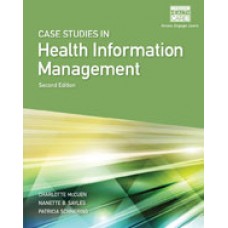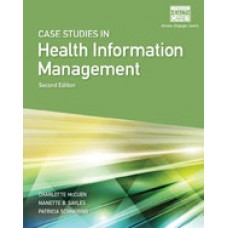This is completed downloadable of Solution Manual for Case Studies for Health Information Management, 2nd Edition

Product Details:
- ISBN-10 : 1133602681
- ISBN-13 : 978-1133602682
- Author: Patricia Schnering
Created specifically for students of Health Information Management and Health Information Technology, this worktext helps bridge the gap between knowledge gained through formal instruction and real-world, on-the-job application. This versatile worktext features 240 case studies with questions and exercises for each case that require you to draw on critical thinking, problem solving, and decision making skills, facilitating the transition from studying theory to analyzing and applying what you have learned. Now updated and expanded, the second edition features the latest RHIA and RHIT domains and competencies, so you can prepare effectively for certification. In addition, new online learning resources provide convenient access to additional web content, online forms, and spreadsheets to complement the cases.
Table of Content:
- Chapter 1: DOMAIN I Data Governance, Content, and Structure
- 1.0 Taxonomies, nomenclatures, and terminologies
- 1.1 Ambulatory surgery data collection
- 1.2 International classification of diseases mapping exercise
- 1.3 Coding audit
- 1.4 Trauma registry audit
- 1.5 Secondary data
- 1.6 Emergency department documentation
- 1.7 Health information exchange data stewardship and integrity
- 1.8 Master patient index data analysis
- 1.9 Screen design evaluation
- 1.10 Providers, roles, and documentation
- 1.11 Health record completion
- 1.12 Master patient index integrity
- 1.13 Patient-generated health data
- 1.14 Assign MS-DRG and APC groupings
- 1.15 Special health record documentation requirements
- 1.16 Physician assistant documentation practices
- 1.17 Interoperability and SNOMED CT
- 1.18 Interoperability
- 1.19 Information governance advocacy
- 1.20 Encoder replacement
- 1.21 Screen design for enterprise master patient index
- 1.22 Cloud computing pros and cons
- 1.23 SNOMED CT versus ICD-10
- 1.24 Patient registration impact on HIM
- 1.25 Research interoperability
- 1.26 Data dictionary and the Joint Commission
- 1.27 Data dictionary maintenance
- 1.28 Data dictionary flaw
- 1.29 Data dictionary mapping
- 1.30 Evolving leadership roles in HIM
- 1.31 HIM leadership roles
- 1.32 Institute of Medicine impact
- 1.33 Accountable care organization, information governance, and strategic planning
- 1.34 Information governance plan
- 1.35 Data dictionary
- 1.36 Managed care versus accountable care
- 1.37 Data stewardship
- 1.38 Data quality management
- 1.39 Information management plan
- 1.40 HIM department strategic plan
- 1.41 Password management
- 1.42 Data quality model
- 1.43 Data integrity
- 1.44 Intrusion detection
- 1.45 Corrections
- 1.46 Telemedicine I
- 1.47 Telemedicine II
- 1.48 Telemedicine III
- Chapter 2: DOMAIN II Information Protection: Access, Use, Disclosure, Privacy and Security
- 2.0 Release of information form
- 2.1 Security policy—HIM student practicum
- 2.2 Information access
- 2.3 Potential privacy violation
- 2.4 HIM staff privacy and security education
- 2.5 Privacy and security education
- 2.6 HIM department breach
- 2.7 Back-ups and e-discovery
- 2.8 Release of information cost
- 2.9 Release of information error
- 2.10 Mobile health technology security
- 2.11 Mobile health technology security II
- 2.12 Disaster recovery planning
- 2.13 Security audit
- 2.14 Patient mix-up
- 2.15 E-discovery preservation
- 2.16 E-discovery sources
- 2.17 Security access controls
- 2.18 Remote access controls
- 2.19 Medical identity theft and personal health records
- 2.20 Medical identity theft
- 2.21 Confidentiality statement
- 2.22 Encryption
- 2.23 Authentication
- 2.24 Release of information policy
- 2.25 Retention and destruction
- 2.26 Network security procedures
- Chapter 3: DOMAIN III Informatics, Analytics, and Data Use
- 3.0 Inpatient census days
- 3.1 Average daily census
- 3.2 Bed occupancy rate and change
- 3.3 Length of stay/average length of stay
- 3.4 Healthcare statistics
- 3.5 IT audit
- 3.6 Electronic signature
- 3.7 Coding intranet
- 3.8 Research methodology
- 3.9 Literature review (Medline)
- 3.10 Informed consent institutional review board
- 3.11 AHIMA Foundation research
- 3.12 Institutional review board—vulnerable populations
- 3.13 Health information exchange models
- 3.14 Health information exchange policies and procedures
- 3.15 Health information exchange challenges
- 3.16 Health information exchange and data integrity
- 3.17 System testing
- 3.18 Data normalization
- 3.19 Desktop versus laptop computers
- 3.20 Thin client
- 3.21 Denial dashboard
- 3.22 Database structure
- 3.23 Delivery statistics
- 3.24 Critical access hospital length of stay
- 3.25 Strategic planning
- 3.26 Release of information tracking log
- 3.27 Best of fit versus best of breed
- 3.28 Data analytics—decision support
- 3.29 Delivery analysis
- 3.30 Data warehouse and modeling
- 3.31 Healthcare Effectiveness Data and Information Set report card
- 3.32 Cancer reporting
- 3.33 Blockchain
- 3.34 Contingency plan
- 3.35 Data analytics
- Chapter 4: DOMAIN IV Revenue Cycle Management
- 4.0 Case mix issue
- 4.1 Case mix issue (continued)
- 4.2 Compliance and case mix
- 4.3 Inpatient-only procedure denials
- 4.4 Chargemaster process
- 4.5 Case management—discharge disposition
- 4.6 Utilization review—two-midnight rule
- 4.7 Advance beneficiary notice process
- 4.8 Resource-based relative value scale
- 4.9 Accounts receivable days
- 4.10 Outpatient Code Editor audit
- 4.11 Chargemaster issue
- 4.12 Chargemaster composition
- 4.13 Chargemaster requisition form
- 4.14 Remittance advice
- 4.15 Claim reconciliation
- 4.16 Electronic data interchange
- 4.17 Hospital-acquired conditions and present on admission
- 4.18 Ambulatory payment classification audit
- 4.19 Claim denial
- 4.20 Anemia query
- 4.21 Coding error
- 4.22 Coding and UHDDS
- 4.23 Computer-assisted coding and fraud detection
- 4.24 Struggling clinical documentation improvement process
- 4.25 Query retention
- 4.26 Query format
- 4.27 Coding audit I
- 4.28 Coding audit II
- 4.29 New staff physician
- 4.30 Clinical documentation improvement monitoring
- 4.31 Compliance policy
- 4.32 Coding review
- 4.33 National Correct Coding Initiative guidelines
- 4.34 Severity of illness and diagnosis-related groups
- 4.35 MS-DRGs
- 4.36 Computer-assisted coding
- 4.37 Computer-assisted coding roadblock
- 4.38 Evaluate computer-assisted coding systems
- 4.39 Evaluate MS-DRG and APC groupings
- Chapter 5: DOMAIN V Health Law and Compliance
- 5.0 Notice of privacy practices
- 5.1 Joint Commission—Do Not Use abbreviations I
- 5.2 Joint Commission—Do Not Use abbreviations II
- 5.3 Present on admission
- 5.4 Present on admission analysis
- 5.5 Tracer methodology
- 5.6 Delinquent medical records
- 5.7 Fraud and abuse focus
- 5.8 Stark anti-kickback
- 5.9 Whistleblower
- 5.10 Bilateral reporting
- 5.11 Compliance policy
- 5.12 Fraud trend analysis
- 5.13 Patient-centered medical home I
- 5.14 Patient-centered medical home II
- 5.15 Videotaping policy
- 5.16 Legal terminology I
- 5.17 Healthcare laws and HIM
- 5.18 Subpoena preparation
- 5.19 Legal document conundrum
- 5.20 Legal health record maintenance
- 5.21 Legal terminology II
- 5.22 Subpoenas and documentation
- 5.23 Subpoenas and testifying
- 5.24 Legal terminology III
- 5.25 Consent
- 5.26 Labor and employment laws
- 5.27 Healthcare policies
- 5.28 Sentinel events
- 5.29 Laboratory billing change
- 5.30 ICD-10-CM notes
- 5.31 Attempted medical identity theft
- 5.32 Claim review—blockchain
- 5.33 Modifier 25 denials
- Chapter 6: DOMAIN VI Organizational Management and Leadership
- 6.0 Release of information for employee training and development
- 6.1 Committee consensus
- 6.2 Transcription performance improvement
- 6.3 Ethical situation
- 6.4 Ethics breach
- 6.5 Ethical dilemma
- 6.6 Ethical decision-making
- 6.7 Preparing for an HIM job interview
- 6.8 HIM job interview
- 6.9 Calculating release of information staffing levels
- 6.10 Coder education
- 6.11 New service impact on coding staff levels
- 6.12 New HIM roles
- 6.13 HIM and the C-suite
- 6.14 Cultural awareness self-assessment
- 6.15 Americans with Disabilities Act and HIM
- 6.16 HIM department diversity
- 6.17 Art of negotiating
- 6.18 Salary negotiation
- 6.19 Identify types of budget variances
- 6.20 Depreciation
- 6.21 Hospital merger
- 6.22 Benchmarking performance
- 6.23 Vendor selection
- 6.24 Project management life cycle
- 6.25 Emergency plan training
- 6.26 Team facilitator
- 6.27 Work redesign
- 6.28 Mentor
- 6.29 Coding productivity standards
- 6.30 Workflow design
- 6.31 Swimlane diagram
- 6.32 Disciplinary action
- 6.33 Coder orientation
- 6.34 Request for information, request for proposal, and budget
- 6.35 Clinical documentation improvement training
- 6.36 Management principles
- 6.37 Project—contract management
- 6.38 Vendor contracts
- 6.39 Project management—Gantt chart
- 6.40 Performance improvement tools
- 6.41 Data collection methods
- 6.42 Discipline
- 6.43 Budgets
- 6.44 Payroll variance
- 6.45 Budgeting process
- 6.46 Cost reporting
- 6.47 Budget variance
- 6.48 Personal health record choices
- 6.49 Social determinants of health
- 6.50 Quality management tools
- 6.51 Change management
- 6.52 Disability and diversity
- 6.53 Electronic health record contract
- 6.54 Patient satisfaction scores
- 6.55 Consumer informatics
- 6.56 Addressing health literacy
- Chapter 7: Extended Cases
- 7.0 Multiple patient admissions
- 7.1 A day in the life of an HIM director
- 7.2 Coding productivity process
- 7.3 Missing laptop
- 7.4 Merging and outsourcing transcription services





